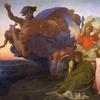From Paris to Polynesia: Paul Gauguin at the Indiana University Art Museum
- BLOOMINGTON, Indiana
- /
- October 01, 2015
The Indiana University Art Museum will display a major painting by French artist Paul Gauguin (1848-1903) during the 2015-16 academic year. The painting, entitled The Invocation, dated 1903, is on loan from the National Gallery of Art in Washington, D.C. The work is being loaned in exchange for the IU Art Museum's painting The Yerres, Effect of Rain by impressionist Gustave Caillebotte (1848-1894) which will appear in the National Gallery's exhibition Gustave Caillebotte: The Painter's Eye.
The Invocation will be featured in a special installation in the IU Art Museum's Gallery of the Art of the Western World. The installation, From Paris to Polynesia: Paul Gauguin at the IU Art Museum, which opened on October 1. Three prints by Gauguin, drawn from the museum's permanent collection, will also be on view.
Considered one of the most important French artists of the 19th century, Paul Gauguin was a leading member of the movement known as Symbolism, which rejected realism in favor of spiritual and dreamlike imagery. Gauguin developed a style characterized by pure, flat color, simplified forms, and spiritual subject matter.
Gauguin spent most of the 1890s in Tahiti, where he incorporated Polynesian imagery and spiritual allusions into his work. Disappointed that Tahitian traditional culture had been largely destroyed by European colonialism, Gauguin moved to the more remote Marquesas Islands in 1901, where he died less than two years later. One of his final works, The Invocation, alludes to the displacement of traditional Polynesian beliefs by Christianity. The painting depicts a nude female figure standing before a verdant landscape with her arms stretched upwards. Her pose of prayer or invocation contrasts with the figure behind her, who wears the long, loose dress introduced to Polynesia by Christian missionaries, and with the small Catholic church visible in the background.
In conjunction with the loan, the Gauguin biopic, The Wolf at the Door, is scheduled to be shown at the IU Cinema on January 10, 2016. Plans are underway for additional programming to take place during the spring semester. Please check the museum's website at www.artmuseum.iu.edu for additional information.










100x100_c.jpg)


![Offering a Truce [Bested], 1895, is estimated to sell for between $1,300,000 and $1,800,000 on March 22, 2014, for The Russell: An Exhibition and Sale to Benefit the C.M. Russell Museum. Offering a Truce [Bested], 1895, is estimated to sell for between $1,300,000 and $1,800,000 on March 22, 2014, for The Russell: An Exhibition and Sale to Benefit the C.M. Russell Museum.](/images/c/a8/20/Dec10_Offering_a_Truce__Bested_300dpi100x100_c.jpg)